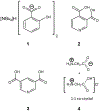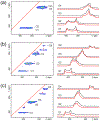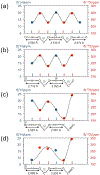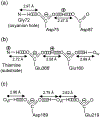1H/17O Chemical Shift Waves in Carboxyl-Bridged Hydrogen Bond Networks in Organic Solids
- PMID: 38748612
- PMCID: PMC11840671
- DOI: 10.1021/acs.jpca.4c01866
1H/17O Chemical Shift Waves in Carboxyl-Bridged Hydrogen Bond Networks in Organic Solids
Abstract
We report solid-state 1H and 17O NMR results for four 17O-labeled organic compounds each containing an extensive carboxyl-bridged hydrogen bond (CBHB) network in the crystal lattice: tetrabutylammonium hydrogen di-[17O2]salicylate (1), [17O4]quinolinic acid (2), [17O4]dinicotinic acid (3), and [17O2]Gly/[17O2]Gly·HCl cocrystal (4). The 1H isotropic chemical shifts found for protons involved in different CBHB networks are between 8.2 and 20.5 ppm, which reflect very different hydrogen-bonding environments. Similarly, the 17O isotropic chemical shifts found for the carboxylate oxygen atoms in CBHB networks, spanning a large range between 166 and 341 ppm, are also remarkably sensitive to the hydrogen-bonding environments. We introduced a simple graphical representation in which 1H and 17O chemical shifts are displayed along the H and O atomic chains that form the CBHB network. In such a depiction, because wavy patterns are often observed, we refer to these wavy patterns as 1H/17O chemical shift waves. Typical patterns of 1H/17O chemical shift waves in CBHB networks are discussed. The reported 1H and 17O NMR parameters for the CBHB network models examined in this study can serve as benchmarks to aid in spectral interpretation for CBHB networks in proteins.
Figures








Similar articles
-
Toward Relatively General and Accurate Quantum Chemical Predictions of Solid-State (17)O NMR Chemical Shifts in Various Biologically Relevant Oxygen-Containing Compounds.J Phys Chem B. 2015 Sep 3;119(35):11618-25. doi: 10.1021/acs.jpcb.5b06536. Epub 2015 Aug 19. J Phys Chem B. 2015. PMID: 26274812 Free PMC article.
-
Solid state NMR studies of hydrogen bonding in a citrate synthase inhibitor complex.Biochemistry. 1999 Jun 22;38(25):8022-31. doi: 10.1021/bi9813680. Biochemistry. 1999. PMID: 10387046
-
Quantifying weak hydrogen bonding in uracil and 4-cyano-4'-ethynylbiphenyl: a combined computational and experimental investigation of NMR chemical shifts in the solid state.J Am Chem Soc. 2008 Jan 23;130(3):945-54. doi: 10.1021/ja075892i. Epub 2008 Jan 1. J Am Chem Soc. 2008. PMID: 18166050
-
Hydrogen Atomic Positions of O-H···O Hydrogen Bonds in Solution and in the Solid State: The Synergy of Quantum Chemical Calculations with ¹H-NMR Chemical Shifts and X-ray Diffraction Methods.Molecules. 2017 Mar 7;22(3):415. doi: 10.3390/molecules22030415. Molecules. 2017. PMID: 28272366 Free PMC article. Review.
-
17 O nuclear magnetic resonance: Recent advances and applications.Magn Reson Chem. 2023 Sep-Oct;61(9-10):507-529. doi: 10.1002/mrc.5378. Epub 2023 Jul 14. Magn Reson Chem. 2023. PMID: 37449419 Review.
References
-
- Huggins ML Hydron bridges in organic compounds. J. Org. Chem 1936, 1, 407–456.
-
- Hendricks SB The orientation of the oxalate group in oxalic acid and some of its salts. Z. Kristallogr 1935, 91, 48–64.
-
- Derissen JL; Smith PH Refinement of the crystal structures of anhydrous [alpha]- and [beta]-oxalic acids. Acta Crystallogr., Sect. B 1974, 30, 2240–2242.
-
- Leiserowitz L Molecular packing modes. Carboxylic acids. Acta Cryst. 1976, B32, 775–802.
Grants and funding
LinkOut - more resources
Full Text Sources

